General Metal and Holloware
 |
John Shaw & Sons
(Wolverhampton) Ltd.
Fourth Avenue, Bushbury |
 |
The Company's products
 |
I display here a very small selection of the company's
products. They are taken from two catalogues: one of about 1930 (which
has kindly been supplied to us Mick Emm, Ted Rawson and Ross Mellows);
and another issued in 1939. It is not always possible to tell
from these catalogues which are things the company made itself,
which are those made by other companies and distributed by Shaw's,
and which are Shaw's own brand products but made for them by someone
else. |
So what I have selected here are a few of those where there
is nothing to show they were not Shaw's own and made at Bushbury. They
are mainly those with the Governor trade mark, which was certainly Shaw's
own, and main, trade mark.
| A plate showing the governor trade mark.
Most companies used brass plates but this one is cast in steel,
once highly polished. |
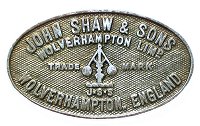 |
It is worth noting that quite a lot of the products in the
catalogues were made in the USA. This shows that Shaw's were into
importing in quite a big way and is some sort of reflection of the
increasing dominance of American manufacturing power. The c.1930
catalogue is a monster affair, containing over 400 pages. The 1939
catalogue contains a little under 300 pages (of the same size). The
later catalogue has a smaller proportion of American made items, fewer
pieces of machinery and a smaller range of variations of standard tools.
If this shows that Shaw's were contracting, it also shows the effects of the
Depression.
I start with the 1939 catalogue because I got it first.
But is shows a very similar range of items to the earlier one. And it
contains literally thousands of items. It starts with about 50
different sorts and sizes of file and then proceeds to numerous saws.
 |
These include this wicked looking item, which turns out
to be their way of displaying 18 different types of circular saw blades.
After that you get band saws, cross cut saws, felling saws, buck saws,
back saws, hack saws, frame saws, hand saws, panel saws, rip saws, tenon
saws, pruning saws, compass saws, pad saws, chain saws, turning saws,
butchers' saws, miners' saws, fret saws, coping saws, as well as saw
blades, saw handles, saw sets and saw tools.
Having sawn your wood, you must need a plane. Shaw's would not
fail you: |
The planes came in wood and metal and great variety, and
were joined by spokeshaves and scrapers. These are followed by edge
tools - many sorts of chisel and, of course, two types of wheeler's bruzzes.
These were by no means all made in Sheffield - Shaw's and other
Wolverhampton manufacturers made a lot of edge tools.
| Then, after marking gauges, we get to bits, which are
represented in this Museum by this Governor Auger Bit Set in Canvas
Roll. There were 9 varieties of these sets alone. And so on
to braces (both chapman's and joiner's and wagon builder's) , bradawls,
rampins, gimlets, screwdrivers, bevels and squares, and then on to some
machinery. |
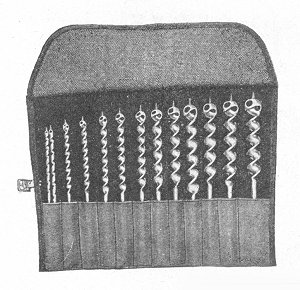 |
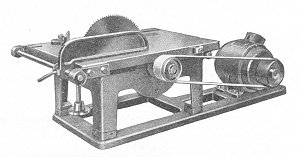 |
Circular saw benches came ready for belt drive or, as in
this case, with an electric motor. These saw benches were some of
the biggest and most complex items in the catalogue. But the
machines include morticing machines, wood trimmers and mitre cutting
machines |
The there is a die selection of cramps, such
as sash cramps, G cramps and even a double prong floor cramp. And note
that they are cramps, not clamps.
| After all the axes and hatchets, there are hammers in
profusion and mallets of all sorts.
All of the sharpening stones and
similar items offered are made by Carborundum, Axolite or Pike. |
 |
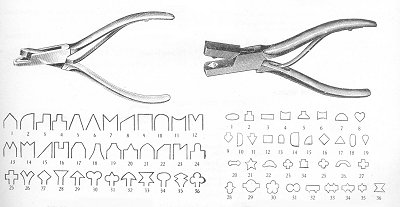 |
The
enormous selection of rules, tapes, plumbs and spirit levels are by Rabone.
But Shaw's seem to make at least some of the nail sets, pin punches, centre
punches and even ticket punches with a great range of shapes to be punched in
tickets. Things now get more specialised with belt fasteners, carpet
stretchers, telegraph and linesmen's tools, and all sorts of tinmens'
snips and tools. |
| A gas heated tinman's stove which will "heat one bit and
keep another nearly ready for use, so that two can be used in succession".
|
 |
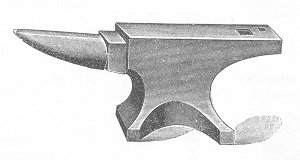 |
As you would expect in this area, though of
course still in very widespread use, there are plenty of blacksmith's tools,
including five different styles of anvil and eight different forges,
either with bellows, or fans. |
| Seven of
thebellows are foot or hand driven and only one has provision for being
belt-driven; none of them seems to be available for use with
electricity. There are also pincers, pliers, cutting nippers, bolt
cutters, spanners, wrenches of all sorts and pipe cutters. |
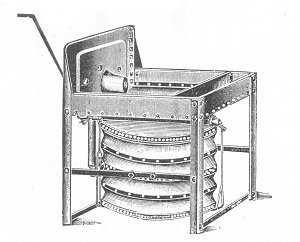 |
 |
The Governor
Amateurs' Unbreakable Vice, which merits inclusion for the maker's
optimism about their products and the skills of amateurs. This,
and a lathe, are the only products in the catalogue which are
specifically mentioned as being suitable for amateurs. DIY was not
the fashionable thing in those days. This amateurs' vice is said
to be "specially suitable for wireless construction and use with motor
cycles and cycles". |
| We pass over five pages of screwing tackle and screwing
machines, and reamers and broaches, not being too sure what they might
be. But this standard wire gauge, one of many gauges, is readily
recognisable. |
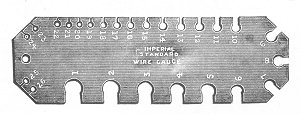 |
The catalogue includes
turning lathes, chucks and tools, 16 hand drills and several drilling
machines. But by this time electric drills are also available and
there are several here, mostly by Wolf. Then there are grinders, some
of them hand driven, most of them belt driven but a few of them electric.
Then we return to specialisms, with moulders' tools, stonemasons' tools and
plasterers' tools.
After several pages of Rawlplug equipment we get on to
blow lamps, brazing lamps, blow torches and stoves.
|

|
Read about blow torches and
stoves |
|
|
|
 |
There are pages of plumbers tools, decorator's tools,
glaziers' tools and a selection of knives, including this example. |
| There are scissors and shears including these
"Miniature or Cemetery Shears". There are plenty of pruning shears
and pruning knives, garden trowels, forks, pruners, hoes and rakes and
even Qualcast and Webb lawn mowers. |
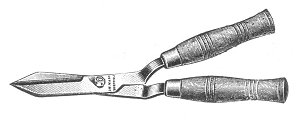 |
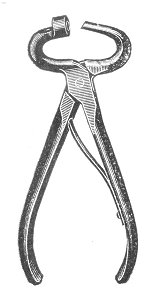 |
Amidst the reaping hooks and shepherds' crooks, we have
reminders of the less picturesque side of farming life. On the
left is one of a selection of bull nose pliers and on the right is a
lamb castrator.
There are cattle ear pliers, which come with a
wide range of cut designs, unpleasantly reminiscent of the bus ticket
punches.
The section ends with a butcher's cleaver. |
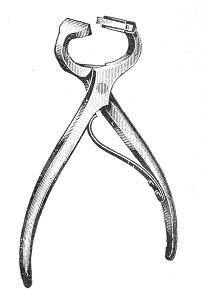 |
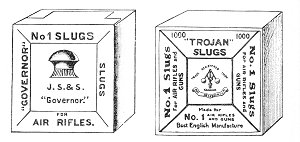 |
There are also gun cleaning accessories, air gun darts and
two sorts of air gun slugs. |
|
The catalogue ends with a wide variety of oil cans.
|
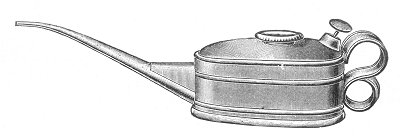 |
I turn now to the c.1930 catalogue, picking out mainly those
things which are different in some way from the 1939 catalogue.
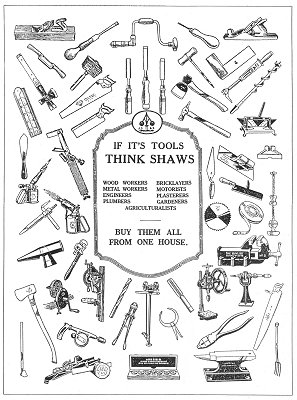 |
This page, a kind of half title, gives an impression
of the range of items which Shaws were distributing. |
The items below come from a page headed "Gentlemen's and Amateurs' Tool
Chests" and "Joiners' Tool Chests". One is in a wood box, stained
walnut, the other is in "selected pine, nicely finished and polished".
You can work out which was whose - and you can also work out what the
difference was between a gentleman and an amateur and then wonder why a
gentleman would want a tool chest at all.
 |
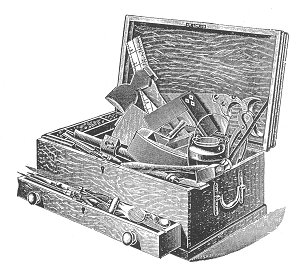 |
| There are several pages devoted to guns, air rifles,
cartridges and accessories, gun cases and covers, game bags and
carriers. Some of the guns and air rifles are attributed to
other makers. |
 |
It is stated that:
"We give careful attention to the repairing, alteration, and
doing up of guns and firearms generally, no matter whether of our make or not".
This suggests that Shaws made some guns, though it may be that
they were simply "own brand" guns made by someone else.
It is notable that by the 1939 catalogue only the cleaning accessories and the
air gun slugs are left.
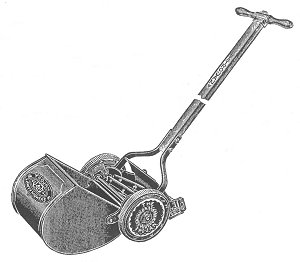 |
This is the Trojan mower. In the original the words
"The Trojan" can clearly be seen on the wheel and, as the catalogue
says, "handle and grass boxes nicely transferred with Trojan devices". And, in the original, the grass box transfer has the "Governor" logo in
the middle. |

Courtesy of Tony Edwards.
| This is the Governor (no mention of Trojan) Motor Lawn
Mower, 17" cut, air cooled.
The engine may well be a Villiers - it looks pretty much like one.
There is also a 22" cut Governor water cooled lawn mower which must have
had its engine from some other source. |
 |
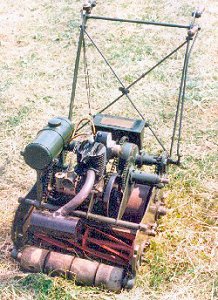 |
These three photos have been kindly provided by Keith
Wootton, who runs the
Old Law Mower Club. They all show mowers made by John Shaw
and Sons.
He writes: "This conventional mower is very similar to a
lot of machines made during the twenties. I am not convinced
it has a Villiers engine. Most motor mowers form the 1920s
with the Villiers engine had the two stroke units with the flywheel
magneto. But the John Shaw has a separate magneto and no
obvious manufacturer's markings, which Villiers was pretty hot on.
A better bet would be a small BSA unit or an obscure manufacturer. |
| This is a more interesting mower, if only because of
its design. The engine is, I believe, a Burgess water cooled
two stroke unit. Interestingly it seems to be almost identical
to another mower, known as the Bee, and made by Burgess of
Brentwood.
I have an advert for that machine, dated 1922.
My guess is that there is a link between the two machines although
the designs are slightly different, most notably because the John
Shaw has a radiator and the Bee does not. |
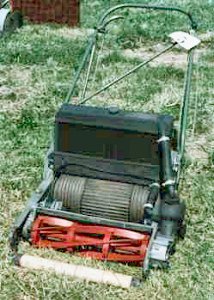 |
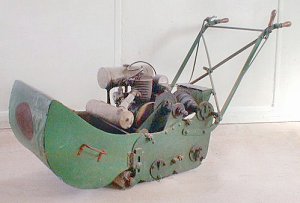 |
This machine is more or less identical to the one
shown in the first photo (which is at the Milton Keynes Museum) and
is now in the British Law Mower Museum at Southport." By 1939 lawn mowers
were no longer included in the list of products. |
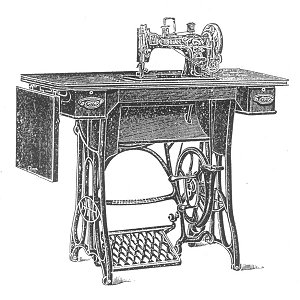 |
There are several pages of Trojan sewing machines, with or
without a pedestal, and all either hand or treadle driven.
"Trojan" is one of Shaw's brand names and these pages are liberally
scattered with their governor logo. The text talks about 50 years'
experience" and "the Makers' reputation for excellence in materials and
workmanship"; and says that "the enormous output of the factories
enables these machines to be marketed at most attractive prices".
All that, and the nature of this sort of machine, suggests to me that
these were not made in Wolverhampton. I would not be surprised to
find they were made in the USA. |
The catalogue - which was primarily aimed at the retailers -
ends up with numerous pages of "carded tools"; and Shaws say they can "card
up any lines that lend themselves to it to suit customers requirements.
The pages are interlarded with snappy slogans such as "Governor carded tools
help you sell!" and "If they see them, they buy them". Almost every
card bears the line "No risk: we cheerfully exchange if not satisfied".
 |
The card on the left carries milliners' pliers - a rather
specialised application. That on the right carries a complete set of
wireless tools. The inner frame is made up of a typical 1920s aerial
array. |
 |

|
|

|
Return
to the beginning |
|
Return
to the list of companies |
|



































